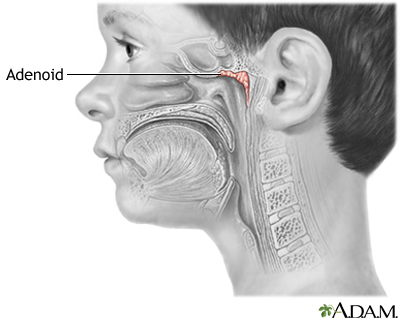Adenoidid: Causes, Symptoms, Diagnosis, and Treatment

Adenoidid is a medical condition characterized by the inflammation or infection of the adenoids—small lymphatic tissues located at the back of the nasal cavity. These adenoids play a vital role in the immune system, especially in young children, as they help filter out bacteria and viruses entering through the nose and mouth. When these tissues become swollen or infected, it leads to adenoidid, causing discomfort, nasal blockage, and breathing difficulties. Understanding adenoidid is crucial for timely diagnosis and effective treatment.
What Is Adenoidid?
Adenoidid refers to the inflammation of the adenoids, often caused by viral or bacterial infections. This condition is most common in children aged 3 to 7 years but can occasionally affect adults. The adenoids naturally shrink with age, which is why adenoidid is less frequent among older individuals.
The inflammation results in enlarged adenoids that can obstruct normal airflow through the nasal passages, leading to breathing through the mouth, nasal speech, and snoring. In some cases, chronic adenoidid can contribute to ear infections or sinus issues.
Causes of Adenoidid
There are several potential causes of adenoidid, and identifying them helps in determining the right treatment approach. Common causes include:
-
Viral Infections: The most frequent cause of adenoidid, such as from adenovirus, rhinovirus, or influenza virus.
-
Bacterial Infections: Bacteria like Streptococcus can cause persistent or recurrent adenoid inflammation.
-
Allergies: Allergic reactions to dust, pollen, or pet dander can trigger swelling of the adenoids.
-
Environmental Factors: Pollution, smoke exposure, and dry air may irritate the nasal passages and contribute to adenoidid.
-
Weak Immune System: Children with weaker immune systems are more susceptible to repeated infections leading to adenoidid.
Common Symptoms of Adenoidid
Recognizing the symptoms of adenoidid early can help prevent complications. The most common signs include:
-
Nasal congestion or blockage
-
Mouth breathing, especially during sleep
-
Snoring or sleep apnea
-
Frequent ear infections
-
Sore throat or difficulty swallowing
-
Nasal-sounding speech
-
Persistent runny nose or postnasal drip
-
Swollen neck glands
Chronic adenoidid can also affect sleep quality, leading to daytime tiredness, irritability, and reduced concentration in children.
Diagnosing Adenoidid
Proper diagnosis of adenoidid involves a physical examination and sometimes imaging tests. Here’s how doctors typically identify the condition:
-
Medical History: A detailed history of symptoms helps identify if the adenoid inflammation is acute or chronic.
-
Physical Examination: The doctor examines the throat, ears, and nasal passages for signs of infection or blockage.
-
Endoscopy: A small, flexible tube with a camera is inserted through the nose to view the adenoids directly.
-
Imaging Tests: X-rays of the head and neck may be used to determine the size of the adenoids.
-
Lab Tests: In cases of persistent infection, bacterial cultures or allergy tests may be performed.
Treatment Options for Adenoidid
Treatment for adenoidid depends on the severity of the condition and its underlying cause. Here are the most common methods:
1. Medical Treatment
-
Antibiotics: For bacterial infections, antibiotics are prescribed to reduce inflammation and fight infection.
-
Nasal Sprays: Steroid-based sprays can help shrink swollen adenoids and ease breathing.
-
Pain Relievers: Medications like acetaminophen or ibuprofen may help relieve pain or fever.
2. Home Remedies and Lifestyle Changes
-
Steam Inhalation: Helps clear nasal passages and reduce congestion.
-
Hydration: Drinking plenty of fluids helps thin mucus and soothe the throat.
-
Humidifier: Using a humidifier in the bedroom keeps the air moist, reducing irritation.
-
Proper Rest: Adequate sleep strengthens the immune system and supports faster recovery.
3. Surgical Treatment (Adenoidectomy)
If adenoidid becomes chronic or causes breathing and hearing problems, surgery might be recommended. Adenoidectomy involves removing the adenoids to prevent recurrent infections. The procedure is safe and commonly performed, especially for children who experience frequent ear infections or sleep disturbances.
Preventing Adenoidid
While it’s not always possible to completely prevent adenoidid, certain steps can reduce the risk:
-
Encourage frequent hand washing to limit exposure to germs.
-
Keep your child’s environment clean and free from dust and smoke.
-
Strengthen immunity through a balanced diet rich in fruits and vegetables.
-
Avoid close contact with individuals suffering from respiratory infections.
-
Ensure regular medical checkups to detect early signs of adenoid swelling.
Adenoidid in Children vs. Adults
Adenoidid primarily affects children because their adenoids are larger and more active in fighting infections. In adults, the adenoids usually shrink or disappear after puberty, making the condition rare. However, when adenoidid occurs in adults, it may be a sign of chronic sinus infections, allergies, or other underlying health issues requiring medical attention.
Possible Complications of Adenoidid
If left untreated, chronic adenoidid can lead to:
-
Frequent ear infections or hearing loss
-
Chronic sinusitis
-
Obstructive sleep apnea
-
Speech difficulties
-
Dental issues due to prolonged mouth breathing
These complications highlight the importance of timely treatment and proper medical supervision.
When to See a Doctor
Consult a healthcare professional if symptoms like persistent nasal blockage, snoring, or mouth breathing continue for more than a week. Early diagnosis can prevent chronic infections and ensure effective treatment for adenoidid.
Conclusion
Adenoidid may seem like a minor condition, but when ignored, it can lead to serious respiratory and ear-related complications. Understanding the causes, symptoms, and treatments of adenoidid is essential for maintaining healthy airways, especially in young children. With proper care—ranging from home remedies to medical or surgical interventions—most cases of adenoidid can be managed successfully, ensuring better breathing and improved overall well-being.




